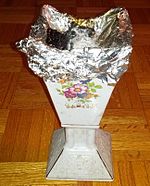| Revision as of 20:03, 10 September 2021 editIljeex (talk | contribs)75 editsNo edit summaryTag: Reverted← Previous edit | Latest revision as of 04:10, 16 October 2024 edit undo82.44.99.15 (talk)No edit summaryTags: Mobile edit Mobile web edit | ||
| (22 intermediate revisions by 15 users not shown) | |||
| Line 1: | Line 1: | ||
| {{Short description|East African incense burner}} | |||
| {{More citations needed|date=July 2024}} | |||
| ] in ] and ].]] | ] in ] and ].]] | ||
| The '''dabqaad''' (] for "fire raiser"), also known as ''' |
The '''dabqaad''' (] for "fire raiser"), also known as '''girgire''', and '''uunsi''' is a ] ] burner, or ]. With either one or two handles, it is commonly used in ], ] and ]. | ||
| ==Usage and production== | ==Usage and production== | ||
| ] | ] | ||
| Dabqaads are traditionally used to perfume homes after large meals and/or during special occasions, such as when one is expecting guests. | Dabqaads are traditionally used to perfume homes after large meals and/or during special occasions, such as when one is expecting guests. | ||
| ] ('' |
] (''foox/fooh'') or a prepared incense (''uunsi''), is placed on top of hot ] inside an incense burner, the ''dabqaad''. It then burns for about ten minutes. This keeps the house fragrant for hours. | ||
| The dabqaad pot is made from a white ] or ] found in specific areas of Somalia |
The dabqaad pot is made from a white ] or ] found in specific areas of Somalia. ] (]) is used to make the dabqaad, with the district of ] serving as a center for ]. El Buur is also the place of origin of the local pipe-making industry. The ancient Egyptian pharaoh ] was very fond of the incense when she went on her expedition to the ancient ].<ref>Abdullahi, pp.98-99</ref> | ||
| ] living in the West often obtain their dabqaads from the ], in person or through relatives. | ] living in the West often obtain their dabqaads from the ], in person or through relatives. | ||
| Line 35: | Line 37: | ||
| | isbn = 978-0-313-31333-2}} | | isbn = 978-0-313-31333-2}} | ||
| ] | ] | ||
| ] | |||
| ] | ] | ||
| ] | ] | ||
| ] | |||
Latest revision as of 04:10, 16 October 2024
East African incense burner| This article needs additional citations for verification. Please help improve this article by adding citations to reliable sources. Unsourced material may be challenged and removed. Find sources: "Dabqaad" – news · newspapers · books · scholar · JSTOR (July 2024) (Learn how and when to remove this message) |

The dabqaad (Somali for "fire raiser"), also known as girgire, and uunsi is a Somali incense burner, or censer. With either one or two handles, it is commonly used in Somalia, Ethiopia and Djibouti.
Usage and production

Dabqaads are traditionally used to perfume homes after large meals and/or during special occasions, such as when one is expecting guests.
Frankincense (foox/fooh) or a prepared incense (uunsi), is placed on top of hot charcoal inside an incense burner, the dabqaad. It then burns for about ten minutes. This keeps the house fragrant for hours.
The dabqaad pot is made from a white clay or soapstone found in specific areas of Somalia. Meerschaum (sepiolite) is used to make the dabqaad, with the district of El Buur serving as a center for quarrying. El Buur is also the place of origin of the local pipe-making industry. The ancient Egyptian pharaoh Hatshepsut was very fond of the incense when she went on her expedition to the ancient Land of Punt.
Somalis living in the West often obtain their dabqaads from the Horn of Africa, in person or through relatives.
See also
Notes
- Abdullahi, pp.98-99
References
- Abdullahi, Mohamed Diriye (2001). Culture and customs of Somalia. Greenwood. ISBN 978-0-313-31333-2.